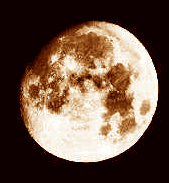|
Is Halloween early this year
as a Blood Moon is set to rise?

Above is a manipulated image to act as an example.
AN early Halloween treat is in stall for us on Monday, 28 September 2015, in the
sky above us. So far, since 1900, only 5 total lunar eclipses have coincided
with a supermoon, with the last taking place back in 1982. This Total Lunar
Eclipses is extremely interesting, as this rare celestial phenomenon sees
the Earth shadow cast on to the Moon turning it a copper colour to deep red.
During a lunar eclipse, depending on the conditions and your location,
you'll see the Earth's shadow, a copper colour dark mark, creeping across
the moon's face. This amazing show will be visible from the most of Northern
Hemisphere and the Southern Hemisphere. For us in the North it will be the
nearest Harvest Moon, or full moon to the September equinox. In the Southern
Hemisphere, it will be the first full moon of spring. During totality, the
Moon's face will suddenly change, appearing a breathtaking deep red colour.
This effect has over the ages been nicknamed "blood moon" and have inspired
myths, legends, and superstitions ever since man started to walk the Earth.
Thankfully we now know that it is not demonic or other evil at play, but the
change of colour happens because of sunlight that is filtered and refracted
by Earth's atmosphere. Earth's atmosphere extends about 50 miles (80
kilometres) above Earth's surface, so the earlier the Eclipse is, the better
the colour. As sunlight passes through our atmosphere, the green to violet
portion of the light spectrum is, filtered out, leaving more of the red
light spectrum illuminating the Moons surface. Think of Sun sets and Sun
rises. The deepness of the colour will also be dependent on atmospheric
conditions. The event can be affected by a range of conditions, from dust,
humidity and temperature. Lets hope no Volcano's erupt, as back in 1992, the
eruption of Mount Pinatubo, in the Philippines, lead to so much dust being
thrown into the Earth's atmosphere, that the totally eclipse of the Moon
could barely be seen in places. For us in the North West of the UK, sadly
the Met Office is predicting cloudy skies, so lets hope they get that wrong,
as the next one like it won't be until 2033! Unlike the Solar Eclipse, this
event will take 5 hours, 11 minutes to go through all the phases. In the UK,
this amazing astronomical show will be in the wee hours of Monday, 28
September 2015, starting with the partial moving left to right, at 1:11am
GMT. totally will be at 3:47am GMT and the end of the 2nd partial and the
Eclipse will be at 5:27am. To find out more facts about the Moon and what
effect it has on us, please click
here.
Other goodies to view as we head into winter will be:-
The conjunction of Mars and Jupiter, that takes place on the night of 17 October
2015. The conjunction will take place in the Northern Hemisphere's predawn sky,
Mars and Jupiter will appear to be very close together, creating a beautiful
conjunction in the sky. So get your binoculars and telescope ready for a closer
look, but you can see it with a naked eye as well, just not as clear!
The latest supermoon of 2015, will be over the night of 27 October/28 October
2015.
Should favourable conditions allow, the next shows will be the annual Draconids
and the Orionids meteor shower. The Draconids will be peek on the 8 October 2015
and then the predawn show of the Orionids, starting on the 21 October and ending
on 23 October 2015. Draconids are best viewed from the Northern Hemisphere and
are very unpredictable and its radiant point is the highest in the sky as
darkness falls, so take out a meteors for this show! Also we suggest you note
that the best viewing for the Orionids, in 2015, will probably be before dawn on
22 October 2015. But also keep an eye out around the midnight to dawn hours, on
both 21 October and 23 October, as you could still see quite of them.
With no moon to hid the show, if cloud free, take note! Over 13 December to 14
December 2015, from mid evening until dawn, the last of the amazing astronomical
offerings for 2015 will take place. This will be the peek of the Geminids meteor
shower. These meteors are often bright and have around 50 to 100 meteors per
hour, visible at the peak. So if you brave the cold air, it should be quite a
show...
Don't get us wrong, as their are many more interesting things taking place above
us, but these are the highlights of the astronomical colander for many amatory
astronomers, like the Taurids meteor shower.
Also if you are interested in the night sky, check out
and/or join:- Liverpool Astronomical
Society (LAS)
Who are the oldest amateur astronomical society in the world, and was
founded in 1881.
UK Students for the Exploration and Development of Space (SEDS),
who are an international student organization whose purpose is to promote
space exploration and development through educational and engineering
projects.
Plus check out Things We Don't Know (TWDK)
website. A site set up by an
ex-Liverpudlian that is dedicated to explaining the questions to which
science is still seeking answers to.
|
